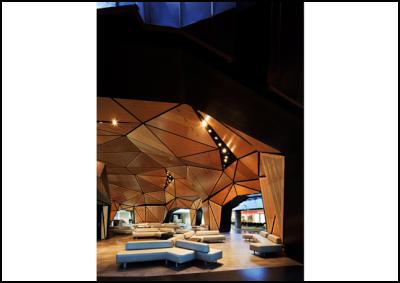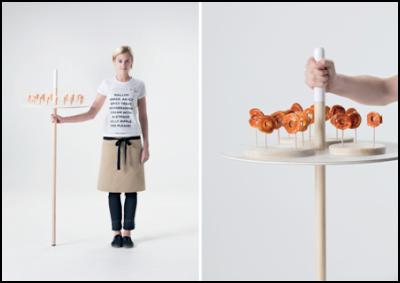The Best New Zealand Designs For 2011
October 10, 2011
A Rock, A Giant Duck, A Possum Trap And A Sleek Racing Bike Feature Among The Best New Zealand Designs For 2011
A sleek, sexy racing bike, a humane possum trap, a rock, a tea towel in the shape of a dead chook, a giant rubber ducky, a bank in a box and a website that allows petrol heads to live out their dreams online, have taken out some of the top accolades at this year’s Best Design Awards – the Oscars of the New Zealand design world.

Organised by the Designers Institute of New Zealand and held at a glittering event attended by more than 690 designers at Auckland’s Viaduct Events Centre on Friday night (October 7), the Best Design Awards recognise and celebrate the country’s best product, spatial, graphic and interactive designs of the year.
A record beating 812 designs were received in this year’s awards, the most ever received in the awards’ 23 year history.
While the competition to take out the title of the country’s best designs was fiercer than ever before, it was Auckland based Avanti Design Technology who rode home with this year’s Purple Pin (supreme award) for Product design, which was presented to the 25 year old Kiwi owned company for the Avanti Project Evo II, a sleek racing bike.

Avanti’s Evo II was released on the market last month and during development it underwent rigorous frame fatigue testing in wind tunnels in North Carolina and San Diego. Avanti bikes are used by a number of New Zealand top athletes such as Bevan Dougherty, Cameron Brown and Commonwealth Games gold medalist, Alison Shanks.
The judges described Avanti’s award-winning bike as “a world-class product demonstrating the highest standards of build, technology and New Zealand design”.
“This amazingly light performance machine demonstrates meticulous attention to detail. The design confidently represents New Zealand in one of the world’s most demanding and exacting sport and recreational arenas.”

In the Spatial design discipline, this year’s Purple Pin went to the new extension at Wellington International Airport (The Rock) designed by Studio Pacific Architecture in association with Warren and Mahoney. The designers, who also won Gold in Public and Institutional Spaces category for their unconventional design, said they had two overriding requirements from their “courageous client,” Wellington International Airport, when designing the terminal addition. It had to “be a memorable experience” and the design had to be “edgy.”
The $39 million extension features an edgy and dramatic design as opposed to the bland arrival and departure halls that typify most international airports. Built to accommodate and process 1000 passengers an hour (instead of the current 500) and to cater for expanded flights to Asia, The Rock was modelled on Wellington’s rugged west coast and takes the form of three rocks clad in 1600 square metres of copper. Inside, the building features macrocarpa panelling and glass fissures which provide warm natural light by day and a glow which can be seen from the air at night.
The judges said the designers had created a unique public space that was “a destination in its own right,” describing the airport extension as “a beautifully executed design that provides travellers with a restful ambience, not usually found in international airports”.

“This is world-class design that puts New Zealand on the map,” said the judges.
For the first time ever in the history of the awards, not one but two designs were awarded the coveted Purple Pin for Graphic design, which were presented to Auckland based Alt Group for their pop-up installation, the Social Kitchen, and to artist Sarah Maxey and typographer, Chris Sowersby for Sentimental Journey, an interpretation of the Exquisite Corpse game, invented by the Surrealists in the early part of last century, where a collection of words is collectively assembled for the entertainment and amusement of the audience, rather like the old parlour game, Consequences.
In this version poet Kate Camp chose a collection of two word phrases, which she then split, sending half to Sarah and the other half to Kris, who then worked independently using their respective skills in typeface design and hand lettering to design each word. Each revealed their designs and words to the other at the end of the project. The combined designs and words, such as Sentimental Journey, Love Heart, I Do (with the “I” being a drawing of an eye) and Screw You, were made into a limited edition set of 20 postcards, available from the Village Foundry website in New York.
Alt Group’s Social Kitchen was a pop-up installation at Britomart created in collaboration with chefs Natalia Schamroth and Carl Koppenhagen of the Engine Room, furniture designer Sam Haughton of IMO and the Fisher & Paykel team for the 2011 Urbis Designday event.
Featuring two kitchen displays within a modified shipping container, a one-off custom table seating 50 people under a 'blow up' cube, and a series of classic New Zealand dishes reinvented, the Social Kitchen was designed to showcase the best in New Zealand appliance design and demonstrate the evolving role of the kitchen as the social hub in Kiwis everyday lives.
Described by the judges as an “artfully coordinated event”, the Social Kitchen project saw Alt Group design everything from wait staff uniforms, to pole based serving platters to a menu, which was presented on t-shirts.
Racing ahead of the competition, Wellington based Resn scored this year’s Purple Pin for Interactive design, which was presented to the company for Sponsafier 4.
Developed for Toyota, the virtual racing car application allowed fans to design, photo shoot and challenge their friends as they created custom cup cars for NASCAR Team Toyota drivers. Fans designed their own paint jobs for the cars, uploading their designs to social networking sites in order to win votes, with the design with the most votes being put onto an actual race car and driven in a big race.
The contest organisers are delighted with the success of the international campaign and say it has taken on a life of its own.
Special Black Pins recognising the contribution individuals have made to the New Zealand design industry were also awarded during the night. The first, the prestigious John Britten Black Pin award for an individual who has made a major contribution to design nationally and internationally, went to Mark Elmore, Head of Industrial Design at Fisher & Paykel, who has been at the forefront of taking the company’s designs and products from a purely domestic market to a wider global audience. The Black Pin for Outstanding Achievement went to Fraser Gardyne, principal of graphic design company gardyneHOLT and past president and a Fellow of the Designers Institute of New Zealand.
Cathy Veninga, CEO of the Designers Institute, said the Institute was delighted by the record number and calibre of designs received in this year’s awards. She said they were especially delighted by the strong showing from Christchurch studios, many of whom had their studios damaged during the earthquakes of the past year yet went on to score some of the evening’s top awards.
Designers Institute president, Professor Tony Parker, who is associate pro vice chancellor at Massey University’s College of Creative Arts, said the best New Zealand designs were often aligned with activities that New Zealanders were good at, such as outdoor and sporting achievements.
“I am also pleased to see that furniture design is coming of age here. It is really encouraging to see a home grown community creating award winning work of international standard.”
Professor Parker, a working product designer, says that New Zealand businesses are beginning to realise the export potential of integrating design into their businesses.
Other
high profile winners at this year’s Best Design Awards
included:
• The Automatic Humane Possum
Trap, designed by Wellington based Goodnature, which won
Gold in the Non Consumer and the Sustainable Product design
sections. Developed with the support of the Department of
Conservation, the trap is powered by a CO2 canister, which,
when a nosey possum pokes around it, gives the animal a
nasty lethal jab. Following rigorous ethics trials, the
trap achieved the Class A standard for humaneness as set out
in the MAF National Animal Welfare Advisory Committee’s
guidelines.
• The Odin Chair by Jamie
McLellan, which won Gold and was designed for a Japanese
hotel chain who asked the designer to think “Norwegian”.
The judges complimented the designer on the “elegant and
sophisticated design combined with a high quality of
construction.”
• FOUR/Duck, which won
Gold for Special Group. In January this year C4 relaunched
as FOUR, and with their mantra, “For the sake of
entertainment” in mind, Special Group brought over Dutch
artist Florentijn Hofman to build a 40ft high inflatable
rubber duck which was released into Auckland’s
Viaduct.
• Restored buildings in Britomart,
including 1885 Britomart and Britomart Country
Club designed by Cheshire Architects, which won Gold in
the Hospitality section.
• Air New Zealand also
starred with the Air New Zealand Uniform Fitting and
Distribution space winning Gold in Office and Workplace
Environments section, and the Air New Zealand Clothes
Hangar Editorial, by Saatchi and Saatchi Design
Worldwide winning Gold in Editorial and Books. The judges
said this grooming standards book blended hard information
“with wit and attitude.”
• Ponsonby based
strategic design company, Alt Group - who scored 23
awards - showed their trademark quirkiness with two of their
winning entries: their own 2010 Xmas gift, a chocolate
keyboard with the Alt key highlighted on the foil wrap, and
a Silver Award winner, the Fisher & Paykel tea towel chook,
where recipients were invited to tie a tea towel in the
shape of a chicken.
• Strategy Design and
Advertising, who won a total of 25 awards, including a
Gold for their new office building, which they designed at
lightning speed after their original office was destroyed
during last September’s earthquakes. Their Share an
Idea campaign also won Gold in the Graphics section.
This was an innovative campaign for Christchurch City
Council developed to get community feedback for the post
earthquake rebuilding programme.
• The “Bank
in a Box” - the innovative Westpac Mobile Bank, designed
by Auckland based Context Architects, that saw a 29 sqm
shipping container quickly converted into a mobile bank in
response to the February 2011 earthquakes, which won bronze.
The mobile bank, which gave the earthquake-ravaged community
of Sumner access to full banking facilities just six weeks
after the devastating quake, is able to be transported
easily to other disaster sites and is flexible for future
uses.
The Best Design Awards were established in 1988 and have been held annually since 1996. All winners can be viewed online at www.bestawards.co.nz
ENDS


 Gordon Campbell: On Fast Track Powers, Media Woes And The Tiktok Ban
Gordon Campbell: On Fast Track Powers, Media Woes And The Tiktok Ban Family First: Just 1 In 6 Oppose ‘Three Strikes’ - Poll
Family First: Just 1 In 6 Oppose ‘Three Strikes’ - Poll Labour Party: Budget Blunder Shows Nicola Willis Could Cut Recovery Funding
Labour Party: Budget Blunder Shows Nicola Willis Could Cut Recovery Funding  Government: Urgent Changes To System Through First RMA Amendment Bill
Government: Urgent Changes To System Through First RMA Amendment Bill Peace Movement Aotearoa: Global Military Spending Increase Threatens Humanity And The Planet
Peace Movement Aotearoa: Global Military Spending Increase Threatens Humanity And The Planet Government: To Introduce Revised Three Strikes Law
Government: To Introduce Revised Three Strikes Law Labour Party: Environmental Protection Vital, Not ‘Onerous’
Labour Party: Environmental Protection Vital, Not ‘Onerous’


